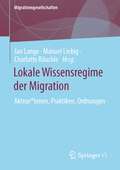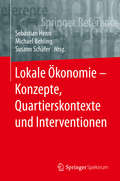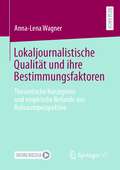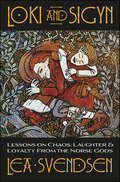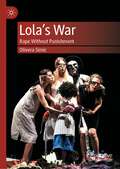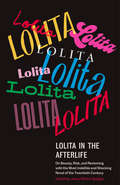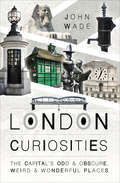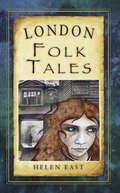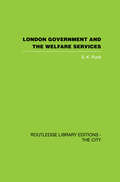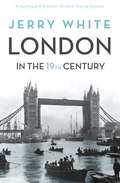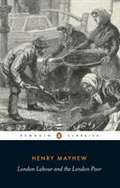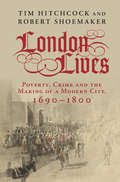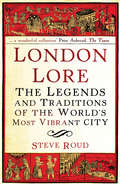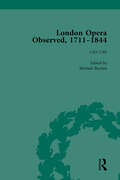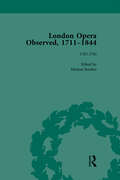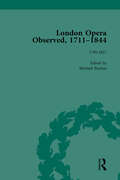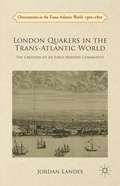- Table View
- List View
Lokale Politikberichterstattung: Inhalte, Leistungen, Formate und Attraktivitätsfaktoren aus der Perspektive des Publikums
by Inge KreutzWie kann lokale Politikberichterstattung möglichst viele Menschen erreichen? Antworten gibt dieses Buch auf der Grundlage von Umfragen und Gruppendiskussionen bei Leser*innen und User*innen von drei crossmedial publizierenden Regionalzeitungen. Es liefert eine Typologisierung des Publikums und zeigt die jeweils spezifischen Ansprüche an lokale Politikberichterstattung auf. Zudem aktualisiert es den Forschungsstand zu Ost-West-Unterschieden und spezifiziert ihn für lokale Politikberichterstattung. Die Doppelrolle der Autorin als Medienwissenschaftlerin und praktische Journalistin begünstigt eine Verbindung der Ansprüche von Theorie und Praxis. Das Buch will eine Diskussion darüber anstoßen, wie Lokaljournalismus in der digitalen Transformation seine Relevanz und Bedeutung erhalten und wie die Versorgung der Gesellschaft auf lokaler und sublokaler Ebene mit demokratierelevanten Informationen gesichert werden kann.
Lokale Wissensregime der Migration: Akteur*innen, Praktiken, Ordnungen (Migrationsgesellschaften)
by Jan Lange Manuel Liebig Charlotte RäuchleDer Band mit neun empirisch fundierten Beiträgen bietet erstmalig eine systematische Annäherung an lokale Wissensregime der Migration in verschiedenen Kommunen in Deutschland und weiteren europäischen Ländern. Die Beiträge eröffnen neue Perspektiven auf Migrationsregime: Sie zeigen anhand unterschiedlicher Fallbeispiele die Kontextgebundenheit und damit auch die Fluidität von lokalen Wissensregimen der Migration in zeitlicher und räumlicher Hinsicht auf. Dabei stellen sie heraus, dass Wissen eine zentrale Funktion in der Steuerung durch lokale Politik und Verwaltung einnimmt und legen offen, wer wie an der Aushandlung lokaler Migrations- und Integrationspolitiken beteiligt ist. Damit setzen die Autor*innen den Zusammenhang von Wissen und Macht in den Mittelpunkt ihres Interesses. Dieser Fokus entspringt der analytischen Motivation, (gegen-)hegemoniale Wissenspraktiken als Wegweiser zum Umgang mit Migration und städtischen Wirklichkeiten zu dekonstruieren.Die ZielgruppeZielgruppe des Sammelbands ist eine wissenschaftlich interessierte Leser*innenschaft, die sich in der interdisziplinären Migrationsforschung verortet.Besonders relevant ist der Band für die Leser*innen, die sich mit der Schnittstelle von Migration und Wissen auf lokaler Ebene in Gegenwart und Vergangenheit beschäftigen.
Lokale Ökonomie – Konzepte, Quartierskontexte und Interventionen
by Sebastian Henn Michael Behling Susann SchäferDas vorliegende Handbuch bietet einen umfassenden systematischen Überblick über das Themenfeld Lokale Ökonomie in Bezug auf Konzepte, Quartierskontexte und Interventionen. In prägnanten Kurzkapiteln diskutieren Wissenschaftler aus unterschiedlichen Disziplinen (Humangeographie, Soziologie, Wirtschaftswissenschaften etc.) sowie Akteure aus der Stadtentwicklungspraxis grundlegende Konzepte der lokalen Ökonomie und verwandte Ansätze, Dynamiken und Prozesse in unterschiedlichen Quartieren sowie Gestaltungsoptionen zur Stärkung lokal-ökonomischer Strukturen in Deutschland. Das Handbuch richtet sich gleichermaßen an Studierende, Wissenschaftler und Praktiker aus der integrierten Stadt- und Quartiersentwicklung.
Lokaljournalistische Qualität und ihre Bestimmungsfaktoren: Theoretische Konzeption und empirische Befunde aus Nahraumperspektive
by Anna-Lena WagnerAnna-Lena Wagner konzipiert in ihrer Arbeit aus sozialintegrativer Perspektive Grundzüge einer lokalen Gesellschaft und befasst sich mit nahraumspezifischen Qualitäten des Journalismus. In einer empirischen Analyse liefert sie erstens detaillierte Befunde zu den Inhalten des Lokaljournalismus: Wie kritisch berichtet er z. B. über politische Angelegenheiten? Wie intensiv kommen 'normale' Bürgerinnen und Bürger bei Fragen des Alltags zu Wort? Welche Relevanz hat die Berichterstattung über Kultur- und Vereinsthemen? Dazu hat die Autorin Daten einer Inhaltsanalyse von 103 Lokalausgaben von Zeitungen und ihren Onlineablegern in Deutschland, erhoben im DFG-Projekt "Lokaljournalismus in Deutschland", sekundäranalytisch ausgewertet. Die Autorin präsentiert zweitens Bestimmungsfaktoren der lokaljournalistischen Qualität, die sie in einem umfangreichen explorativen Vorgehen ermittelt hat. Sie zeigt auf, inwiefern Faktoren verschiedener Analyseebenen (z. B. redaktionelle Strukturen, Wettbewerbssituation von Zeitungen, gesellschaftlicher Kontext) die Qualität (mit-)bestimmen.
Loki and Sigyn: Lessons on Chaos, Laughter & Loyalty from the Norse Gods
by Lea SvendsenUncover the Truth about Loki and His Devoted Wife SigynThis captivating book takes you deep into the infamous legacy of Loki and the quiet power of Sigyn, the goddess of loyalty and compassion. As a controversial figure in Heathenry, Loki is often approached with trepidation. But this book introduces you to his true self: a trickster, but also a loving husband and creative problem-solver.Join Heathen author Lea Svendsen on a rich exploration of these two Norse deities, together and separate. Discover their adventures in parenthood, their complicated relationships with the other gods, and their entertaining exploits. Learn how to set up an altar to each of them, what offerings they like, and how to perform rituals. You'll also enjoy compelling thoughts on Loki and Sigyn from Pagan and Heathen leaders, such as Patricia Lafayllve and Erika Wren.Includes a foreword by Mortellus, author of Do I Have to Wear Black?
Loktantrik Rajniti Bhag-1 class 9 - JCERT: लोकतांत्रिक राजनीति भाग-१ ९वीं कक्षा - जेसीईआरटी
by Jharkhand Shaikshik Anusandhan Evam Prashikshan Parishad Ranchiयह पुस्तक "लोकतांत्रिक राजनीति" कक्षा 9 की राजनीति विज्ञान के विषय पर आधारित है, जिसमें लोकतंत्र की परिभाषा, इसकी विशेषताएँ और इसके महत्व को सरल भाषा में समझाया गया है। इसमें लोकतंत्र का परिचय, संविधान निर्माण, चुनावी राजनीति और लोकतांत्रिक संस्थाओं का कार्यक्षेत्र बताया गया है। पुस्तक का मुख्य उद्देश्य विद्यार्थियों को राजनीति के सिद्धांत और वास्तविकता से परिचित कराना है ताकि वे लोकतंत्र के महत्त्व और इसकी जटिलताओं को समझ सकें। विभिन्न अध्यायों के माध्यम से लोकतंत्र की परिभाषा, लोकतंत्र के चुनावी प्रक्रिया, अधिकार और कर्तव्यों पर चर्चा की गई है। इसमें बताया गया है कि लोकतंत्र सिर्फ सरकार का एक स्वरूप नहीं है, बल्कि यह नागरिकों के लिए एक जिम्मेदारी और उनके अधिकारों की सुरक्षा का भी साधन है। पुस्तक में चित्र, कार्टून और कथाओं का प्रयोग करके विद्यार्थियों को विषय की ओर आकर्षित करने की कोशिश की गई है। इसके साथ-साथ, किताब में राजनीति की पेचीदगियों और संवैधानिक ढांचे पर भी गहन चर्चा की गई है ताकि छात्र इन सिद्धांतों को अपने जीवन और समाज में लागू कर सकें।
Loktantrik Rajniti Bhag-2 class 10 - JCERT: लोकतांत्रिक राजनीति भाग-२ १०वीं कक्षा - जेसीईआरटी
by Jharkhand Shaikshik Anusandhan Evam Prashikshan Parishad Ranchiलोकतांत्रिक राजनीति - 2 कक्षा 10 की राजनीति विज्ञान की पुस्तक है, जो लोकतंत्र, सत्ता की साझेदारी, संघवाद, सामाजिक विविधता, और जाति, धर्म व लैंगिक मुद्दों पर केंद्रित है। इसमें बेल्जियम और श्रीलंका जैसे देशों के उदाहरणों के माध्यम से सत्ता के विकेंद्रीकरण की आवश्यकता को समझाया गया है। पुस्तक बताती है कि लोकतंत्र में सत्ता का बंटवारा न केवल विभिन्न सामाजिक समूहों के बीच टकराव को कम करता है, बल्कि राजनीतिक स्थिरता को भी बढ़ावा देता है। इसके साथ ही, संघीय ढांचे की महत्ता, जाति-धर्म की राजनीति, और राजनीतिक दलों की भूमिका पर भी प्रकाश डाला गया है, जिससे लोकतंत्र को अधिक समावेशी और उत्तरदायी बनाने के प्रयास किए गए हैं।
Lola’s War: Rape Without Punishment
by Olivera SimicThis longitudinal study is based on the story of Lola, who was gang raped during the war in Bosnia and Herzegovina in 1992. At the time, she was in a detention camp with her young children. Only one of Lola’s several perpetrators was convicted but his sentence of six years of imprisonment has never been actioned by the Bosnian judiciary. Lola’s rapist is still free and she lives in continual fear that he will retaliate against her and her children for her role in his trial.
Lolita in the Afterlife: On Beauty, Risk, and Reckoning with the Most Indelible and Shocking Novel of the Twentieth Century
by Edited by Jenny Minton QuigleyA vibrant collection of sharp and essential modern pieces on Vladimir Nabokov&’s perennially provocative book—with original contributions from a stellar cast of prominent twenty-first century writers.In 1958, Vladimir Nabokov&’s Lolita was published in the United States to immediate controversy and bestsellerdom. More than sixty years later, this phenomenal novel generates as much buzz as it did when originally published. Central to countless issues at the forefront of our national discourse—art and politics, race and whiteness, gender and power, sexual trauma—Lolita lives on, in an afterlife as blinding as a supernova. Lolita in the Afterlife is edited by the daughter of Lolita&’s original publisher in America.WITH CONTRIBUTIONS BYRobin Givhan • Aleksandar Hemon • Jim Shepard • Emily Mortimer • Laura Lippman • Erika L. Sánchez • Sarah Weinman • Andre Dubus III • Mary Gaitskill • Zainab Salbi • Christina Baker Kline • Ian Frazier • Cheryl Strayed • Sloane Crosley • Victor LaValle • Jill Kargman • Lila Azam Zanganeh • Roxane Gay • Claire Dederer • Jessica Shattuck • Stacy Schiff • Susan Choi • Kate Elizabeth Russell • Tom Bissell • Kira Von Eichel • Bindu Bansinath • Dani Shapiro • Alexander Chee • Lauren Groff • Morgan Jerkins
London
by Robert O. Bucholz Joseph P. WardBetween 1550 and 1750 London became the greatest city in Europe and one of the most vibrant economic and cultural centres in the world. This book is a history of London during this crucial period of its rise to world-wide prominence, during which it dominated the economic, political, social and cultural life of the British Isles, as never before nor since. London incorporates the best recent work in urban history, contemporary accounts from Londoners and tourists, and fictional works featuring the city in order to trace London's rise and explore its role as a harbinger of modernity, while examining how its citizens coped with those achievements. London covers the full range of life in London, from the splendid galleries of Whitehall to the damp and sooty alleyways of the East End. Readers will brave the dangers of plague and fire, witness the spectacles of the Lord Mayor's Pageant and the hangings at Tyburn, and take refreshment in the city's pleasure-gardens, coffee-houses and taverns.
London Clubland: A Companion for the Curious
by Seth Alexander ThévozStep into the hidden world of London's private members' clubs with London Clubland: A Companion for the Curious. This guide, by the leading historian on the subject, offers a fascinating insight into these legendary institutions. Culture, history and traditions are all explained - from aristocratic haunts like Boodle's and Brooks's, to modern icons like Soho House and the Groucho Club.Insightful and entertaining, London Clubland is your ultimate guide and almanac to this world, from navigating the application process, to the unwritten rules that define these spaces - not to mention a wealth of trivia assembled over twenty years. Readers will discover mottos, maps, songs and club recipes, as well as little-known facts that some of London's most iconic clubs probably wouldn't want you to know.Whether you are a long-standing member, a reciprocal visitor, an aspiring applicant, or simply just curious about this secretive world, London Clubland offers an engaging and revealing tour through some of London's most discreet institutions.
London Clubland: A Companion for the Curious
by Seth Alexander ThévozStep into the hidden world of London's private members' clubs with London Clubland: A Companion for the Curious. This guide, by the leading historian on the subject, offers a fascinating insight into these legendary institutions. Culture, history and traditions are all explained - from aristocratic haunts like Boodle's and Brooks's, to modern icons like Soho House and the Groucho Club.Insightful and entertaining, London Clubland is your ultimate guide and almanac to this world, from navigating the application process, to the unwritten rules that define these spaces - not to mention a wealth of trivia assembled over twenty years. Readers will discover mottos, maps, songs and club recipes, as well as little-known facts that some of London's most iconic clubs probably wouldn't want you to know.Whether you are a long-standing member, a reciprocal visitor, an aspiring applicant, or simply just curious about this secretive world, London Clubland offers an engaging and revealing tour through some of London's most discreet institutions.
London Curiosities: The Capital's Odd & Obscure, Weird & Wonderful Places
by John WadeLondon is full of curiosities. Who knew that beneath the Albert Memorial lies a chamber resembling a church crypt? Or that there are catacombs under Camden? Who would expect to find a lighthouse in East London, sphinxes in South London, dummy houses in West London, or a huge bust of film director Alfred Hitchcock in North London? <p><p> How many of those who walk past Cleopatra’s Needle pause to consider why a 3,000-year-old Egyptian monument stands beside the Thames? How many know that what was once London’s smallest police station can be seen in Trafalgar Square? Or that pineapples are used in the architectural design of so many buildings? Or why there are memorials to the Mayflower and Pilgrim Fathers in Rotherhithe? Learn more about the capital of curiosities in this delightful guide for lovers of history, trivia, and travel.
London Folk Tales (Folk Tales: United Kingdom)
by Helen EastLondon is a world unto itself; an outrageous, quirky and diverse microcosm where all walks of life cross paths, their languages jostling and mingling – and there are tales whichever way you turn. Now thirty of the best, drawn from oral history and newly recorded local reminiscence, as well as folk sources and written texts, have been brought to life by a mistress of storytelling. Here you will find Dick Whittington alongside the patron saint of cobblers, a royal rat rubbing shoulders with the Maid Uncumber, and fish that decide destinies. Revisit old friends and discover new ones in this wonderful selection of London folk tales – as light and dark, and as full of unexpected twists, as the streets of London itself.
London In The Nineteenth Century: 'A Human Awful Wonder of God'
by Jerry WhiteJerry White's London in the Nineteenth Century is the richest and most absorbing account of the city's greatest century by its leading expert.London in the nineteenth century was the greatest city mankind had ever seen. Its growth was stupendous. Its wealth was dazzling. Its horrors shocked the world. This was the London of Blake, Thackeray and Mayhew, of Nash, Faraday and Disraeli. Most of all it was the London of Dickens. As William Blake put it, London was 'a Human awful wonder of God'.In Jerry White's dazzling history we witness the city's unparalleled metamorphosis over the course of the century through the daily lives of its inhabitants. We see how Londoners worked, played, and adapted to the demands of the metropolis during this century of dizzying change. The result is a panorama teeming with life.
London Labour And The London Poor (Classics Series)
by Henry Mayhew Victor E. NeuburgLondon Labour and the London Poor originated in a series of articles, later published in four volumes, written for the Morning Chronicle in 1849 and 1850 when journalist Henry Mayhew was at the height of his career. Mayhew aimed simply to report the realities of the poor from a compassionate and practical outlook. This penetrating selection shows how well he succeeded: the underprivileged of London become extraordinarily and often shockingly alive. For more than seventy years, Penguin has been the leading publisher of classic literature in the English-speaking world. With more than 1,700 titles, Penguin Classics represents a global bookshelf of the best works throughout history and across genres and disciplines. Readers trust the series to provide authoritative texts enhanced by introductions and notes by distinguished scholars and contemporary authors, as well as up-to-date translations by award-winning translators.
London Labour and the London Poor: A Cyclopædia Of The Condition And Earnings Of Those That Will Work, Those That Cannot Work, And Those That Will Not (London Labour And The London Poor - 4-volume Set Ser.)
by Henry MayhewLondon Labour and the London Poor originated in a series of newspaper articles written by the great journalist Henry Mayhew between 1849 and 1850. A dozen years later, it had grown into the fullest picture we have of labouring people in the world's greatest city in the nineteenth century: a four volume account of the hopes, customs, grievances and habits of the working-classes that allows them to tell their own stories. Combining practicality with compassion, Mayhew worked unencumbered by political theory and strove solely to report on the lives of the London poor, their occupations and trades. This selection shows how well he succeeded. From costermongers to ex-convicts, from chimney-sweeps to vagrants, the underprivileged of London are uniquely brought to life - their plight expressed through a startling blend of first person accounts, Mayhew's perceptions, and sharp statistics.
London Lives
by Tim Hitchcock Robert ShoemakerLondon Lives is a fascinating new study which exposes, for the first time, the lesser-known experiences of eighteenth-century thieves, paupers, prostitutes and highwaymen. It charts the experiences of hundreds of thousands of Londoners who found themselves submerged in poverty or prosecuted for crime, and surveys their responses to illustrate the extent to which plebeian Londoners influenced the pace and direction of social policy. Calling upon a new body of evidence, the book illuminates the lives of prison escapees, expert manipulators of the poor relief system, celebrity highwaymen, lone mothers and vagrants, revealing how they each played the system to the best of their ability in order to survive in their various circumstances of misfortune. In their acts of desperation, the authors argue that the poor and criminal exercised a profound and effective form of agency that changed the system itself, and shaped the evolution of the modern state.
London Lore: The legends and traditions of the world's most vibrant city
by Steve RoudIn which part of North London were wild beasts once thought to roam the sewers? Why did 1920s working-class Londoners wear necklaces of blue beads?Who was the original inspiration for the 'pearly king' costume?And did Spring-heeled Jack, scourge of Victorian London, ever really exist?Exploring everything from local superstitions and ghost stories to annual customs, this is an enchanting guide to the ancient legends and deep-rooted beliefs that can be found the length and breadth of the city.
London Opera Observed 1711-1844, Volume II: 1763-1782
by Michael BurdenThe thrust of these five volumes is contained in their title, London Opera Observ’d. It takes its cue from the numerous texts and volumes which — during the seventeenth, eighteenth and nineteenth centuries — used the concept of ‘spying’ or ‘observing’ by a narrator, or rambler, as a means of establishing a discourse on aspects of London life. The material in this five-volume reset edition examines opera not simply as a genre of performance, but as a wider topic of comment and debate. The stories that surrounded the Italian opera singers illuminate contemporary British attitudes towards performance, sexuality and national identity. The collection includes only complete, published material organised chronologically so as to accurately retain the contexts in which the original readers encountered them — placing an emphasis on rare texts that have not been reproduced in modern editions. The aim of this collection is not to provide a history of opera in England but to facilitate the writing of them or to assist those wishing to study topics within the field. Headnotes and footnotes establish the publication information and provide an introduction to the piece, its author, and the events surrounding it or which caused its publication. The notes concentrate on attempting to identify those figures mentioned within the texts. The approach is one of presentation, not interpretation, ensuring that the collection occupies a position that is neutral rather than polemical.
London Opera Observed 1711-1844, Volume III: 1783-1792
by Michael BurdenThe thrust of these five volumes is contained in their title, London Opera Observ’d. It takes its cue from the numerous texts and volumes which — during the seventeenth, eighteenth and nineteenth centuries — used the concept of ‘spying’ or ‘observing’ by a narrator, or rambler, as a means of establishing a discourse on aspects of London life. The material in this five-volume reset edition examines opera not simply as a genre of performance, but as a wider topic of comment and debate. The stories that surrounded the Italian opera singers illuminate contemporary British attitudes towards performance, sexuality and national identity. The collection includes only complete, published material organised chronologically so as to accurately retain the contexts in which the original readers encountered them — placing an emphasis on rare texts that have not been reproduced in modern editions. The aim of this collection is not to provide a history of opera in England but to facilitate the writing of them or to assist those wishing to study topics within the field. Headnotes and footnotes establish the publication information and provide an introduction to the piece, its author, and the events surrounding it or which caused its publication. The notes concentrate on attempting to identify those figures mentioned within the texts. The approach is one of presentation, not interpretation, ensuring that the collection occupies a position that is neutral rather than polemical.
London Opera Observed 1711-1844, Volume IV: 1799-1821
by Michael BurdenThe thrust of these five volumes is contained in their title, London Opera Observ’d. It takes its cue from the numerous texts and volumes which — during the seventeenth, eighteenth and nineteenth centuries — used the concept of ‘spying’ or ‘observing’ by a narrator, or rambler, as a means of establishing a discourse on aspects of London life. The material in this five-volume reset edition examines opera not simply as a genre of performance, but as a wider topic of comment and debate. The stories that surrounded the Italian opera singers illuminate contemporary British attitudes towards performance, sexuality and national identity. The collection includes only complete, published material organised chronologically so as to accurately retain the contexts in which the original readers encountered them — placing an emphasis on rare texts that have not been reproduced in modern editions. The aim of this collection is not to provide a history of opera in England but to facilitate the writing of them or to assist those wishing to study topics within the field. Headnotes and footnotes establish the publication information and provide an introduction to the piece, its author, and the events surrounding it or which caused its publication. The notes concentrate on attempting to identify those figures mentioned within the texts. The approach is one of presentation, not interpretation, ensuring that the collection occupies a position that is neutral rather than polemical.
London Patidars: A Case Study in Urban Ethnicity (Routledge Revivals)
by Harald Tambs-LycheFirst Published in 1980, London Patidars presents the case study of the Patidars, a landowning caste from the Indian state of Gujarat, in London. Patidars being the landowning caste has taken over much of the ideology of the merchant castes. This ‘merchant ideal’ is a central part of their self-image. It is an incitement to initiative in business and to some extent their actual economic behaviour does reflect the ideal. But the cases studied do not all conform to this ideal, and they pose questions: How does this particular type of ethnic boundary relate to the opportunities of the individual Patidar? Why and how is this boundary maintained? Harald Tambs-Lyche concludes that the form given to the ethnic boundary is advantageous to many Patidars but not to all in the same degree. This raises problems which potentially could change the present pattern. Other potential problems relate to their relationship with the English. As successful merchants they risk becoming objects of envy like, formerly, the Jewish community. This book is a must read for scholars of ethnic and race relations and sociology.
London Quakers in the Trans-Atlantic World
by Jordan LandesThis book explores the Society of Friend's Atlantic presence through its creation and use of networks, including intellectual and theological exchange, and through the movement of people. It focuses on the establishment of trans-Atlantic Quaker networks and the crucial role London played in the creation of a Quaker community in the North Atlantic.

